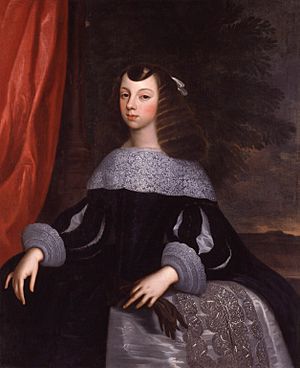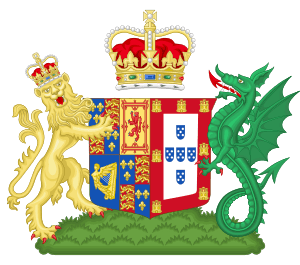Catherine of Braganza facts for kids
Quick facts for kids Catherine of Braganza |
|
|---|---|
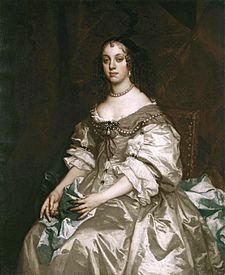
Portrait by Peter Lely, c. 1663–65
|
|
| Queen consort of England, Scotland and Ireland | |
| Tenure | 21 May 1662 – 6 February 1685 |
| Born | 25 November 1638 Palace of Vila Viçosa, Vila Viçosa, Portugal |
| Died | 31 December 1705 (aged 67) Bemposta Palace, Lisbon, Portugal |
| Burial | Pantheon of the House of Braganza, Lisbon |
| Spouse | |
| House | Braganza |
| Father | John IV of Portugal |
| Mother | Luisa de Guzmán |
| Religion | Catholic |
| Signature | |
Catherine of Braganza (Portuguese: Catarina de Bragança; 25 November 1638 – 31 December 1705) was the Queen of England, Scotland, and Ireland. She became queen when she married King Charles II on 21 May 1662. Their marriage lasted until his death on 6 February 1685.
Catherine was the daughter of John IV of Portugal. He became the first king from the House of Braganza in 1640. He helped Portugal regain its independence after 60 years of Spanish rule. After her husband died, Catherine returned to Portugal. She served as a temporary ruler (regent) for her brother, Peter II, in 1701 and again from 1704 to 1705.
Catherine was raised as a Roman Catholic. This made her unpopular in England, which was mostly Protestant. She faced challenges because of her faith. People spread false rumors about her, but King Charles II always protected her. Catherine and Charles did not have any children together. Charles had many children with other women, but he never divorced Catherine.
Contents
Early Life in Portugal
Catherine was born in the Ducal Palace of Vila Viçosa in Portugal. She was the second daughter of John, 8th Duke of Braganza, and his wife, Luisa de Guzmán. Her father became King John IV of Portugal in 1640. This made Portugal an important country in Europe.
Portugal also had a large colonial empire at the time. Because of her father's position, Catherine was a good choice for a royal marriage. She was considered as a possible wife for several European rulers. These included Louis XIV of France and Charles II of England.
Catherine grew up in Lisbon, Portugal. She had a happy childhood. Her mother, Queen Luisa, was very involved in her children's education. Catherine spent much of her youth in a convent near the royal palace. She had a very sheltered upbringing. One person at the time said she "hardly been ten times out of the palace in her life." Catherine's older sister died in 1653. This made Catherine the oldest surviving child. Her mother, who ruled Portugal after her father's death, chose Charles II as Catherine's husband.
Marriage to Charles II
Negotiations for Catherine's marriage to King Charles II began even before Charles became king. They started again after he returned to the throne in 1660. On 23 June 1661, the marriage contract was signed. England gained control of Tangier in North Africa and the Seven Islands of Bombay in India. England also received special trading rights in Brazil and the Portuguese East Indies. English people living in Portugal were given religious and business freedom. Portugal received military help from England against Spain. Catherine was also allowed to practice her Catholic faith freely.
Catherine arrived in Portsmouth on 13 May 1662. Charles visited her on 20 May. The next day, they were married in Portsmouth. They had two ceremonies: a private Catholic one and a public Anglican service.
On 30 September 1662, the royal couple entered London in a grand procession. It included the Portuguese group and many court members. There were musicians playing shawms and Portuguese bagpipes. These were the new Queen's favorite instruments. The procession crossed a special bridge built for the event. It led to the palace where Charles's mother, Queen Henrietta Maria, waited. This was followed by celebrations and fireworks.
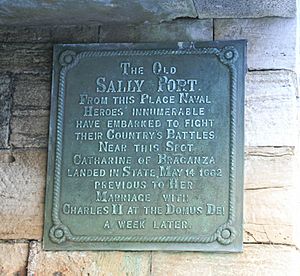
Catherine had many good qualities. However, she had grown up in a convent, away from the world. She was not the type of wife Charles might have chosen himself. His mother liked her very much. She wrote that Catherine was "the best creature in the world." She also said, "I have the joy to see the King love her extremely. She is a Saint!" In reality, their marriage was not always happy.
Catherine became pregnant several times but did not have any children who survived. After this, it seemed unlikely she would have an heir. Some royal advisors wanted Charles to divorce her. They hoped he would marry a Protestant woman who could have children. But Charles refused to divorce Catherine. She remained loyal to him throughout their marriage.
Queen Consort (1662–1685)
Catherine was not a popular choice for queen at first. This was because she was Roman Catholic. Her religion prevented her from being crowned in an Anglican ceremony. She also struggled with the language barrier and the religious differences in England. Over time, her quiet nature, loyalty, and true affection for Charles changed how the public saw her.
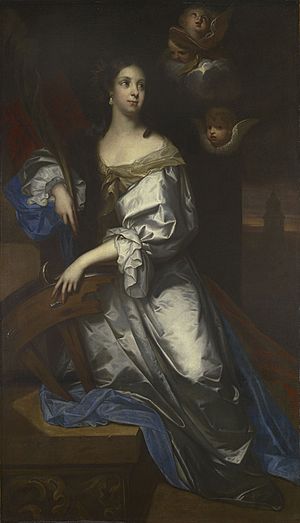
As time passed, Catherine became more comfortable. She began to enjoy court life. She loved playing cards, even on Sundays, which shocked some strict Protestants. She enjoyed dancing and organizing masques (fancy dress parties). She loved the countryside and picnics. Fishing and archery were also favorite hobbies. In 1670, she visited Audley End House with her ladies-in-waiting. She tried to attend a country fair disguised as a village maiden. But she was soon recognized and had to leave quickly because of the crowds. In 1664, her favorite painter, Jacob Huysmans, painted her as Saint Catherine. This started a trend among other court ladies.
Catherine did not get involved in English politics. Instead, she kept an active interest in her home country, Portugal. She wanted to improve relations with the Pope. She also hoped to get recognition for Portugal's independence. She sent letters to the Pope and cardinals in Rome. In 1669, she tried to help with the siege of Candia in Crete by the Ottoman Empire. She failed to convince her husband to take action. In 1670, she received religious items from Pope Clement X. This showed his growing favor towards her. That same year, Charles II ordered a royal yacht, HMY Saudadoes, for her. It was used for pleasure trips and to keep in touch with Portugal.
Catholic Faith
Catherine was known for her strong Catholic faith. This made her a target for people who disliked Catholics. Her husband, King Charles, admired her deep religious devotion. She had several priests in her household. In 1665, Catherine decided to build a religious house for thirteen Portuguese Franciscans. It was completed by 1667 and became known as The Friary.
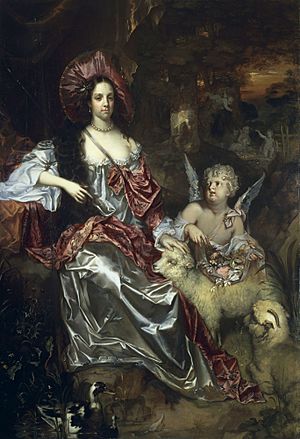
In 1675, Catherine became ill again. Her doctors believed it was due to stress. This stress came from the possibility of Charles divorcing her. In the same year, all Irish and English Catholic priests were ordered to leave the country. This left Catherine relying on foreign priests. As rules against Catholics became stricter, Catherine appointed her friend, Francisco de Mello, as her Lord Chamberlain. This was unusual, but the King allowed it to please Catherine. However, de Mello was dismissed the next year for printing a Catholic book. This left Catherine feeling even more alone at court.
Popish Plot Accusations
The Test Act of 1673 had removed all Catholics from public jobs. Anti-Catholic feelings grew stronger. As the highest-ranking Catholic in the country, Catherine became a target. In 1678, she was falsely accused of being involved in a plot against the King. These accusations were part of what was called the Popish Plot.
However, Catherine was safe because her husband, Charles, trusted her completely. He said she "could never do anything wicked." The House of Lords, who knew and liked her, refused to accuse her. After this, Catherine and Charles became even closer. Catherine wrote about Charles's "wonderful kindness" to her. People noticed that he spent more time with her.
Later Life and Death
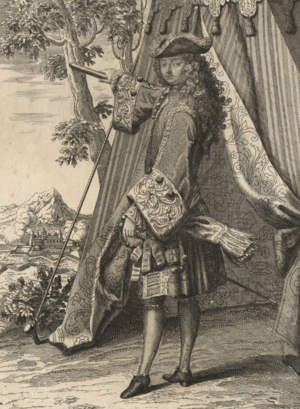
When King Charles II was dying in 1685, Catherine was very worried about him. She hoped he would return to the Catholic faith. She was very sad when he died. She sent a message asking for his forgiveness if she had ever offended him. Charles replied, "Alas poor woman! she asks for my pardon? I beg hers with all my heart."
Catherine stayed in England during the reign of James II. She also remained after James was removed from the throne in the Glorious Revolution. This was when William III and Mary II became rulers. She finally returned to Portugal in March 1692.
In Portugal, she supported the Methuen Treaty in 1703. This was an important agreement between Portugal and England. She served as regent for her brother, Peter II, in 1701 and from 1704 to 1705. Catherine died at the Bemposta Palace in Lisbon on 31 December 1705. She was buried at the Monastery of São Vicente de Fora in Lisbon.
Legacy
Catherine is often given credit for making tea drinking popular in Britain. Before her, tea was not common there. Her arrival also helped bring other goods to England. These included cane, lacquer, cottons, and porcelain.
Queens, a borough of New York City, is thought to be named after Catherine of Braganza. This is because she was queen when Queens County was created in 1683. Other boroughs like Kings County (named after her husband, King Charles II) and Richmond County (named after Charles's son) also have royal names. However, there is no clear historical proof that Queens was directly named after her.
In 1983, a group called "Friends of Queen Catherine" tried to build a large statue of her in Long Island City. The project had support from some important people. But historians and other groups objected. They said there was no proof Queens was named after her. They also raised concerns about her family's possible links to the slave trade. Because of this opposition, the statue was never built. A smaller model of the statue can be seen in Lisbon, Portugal.
Catherine Street in central London is named after her. Many novelists have written about Queen Catherine. They often show her in a kind and understanding way. Her marriage also had a big impact on the history of India. The Seven Islands of Bombay were part of her dowry. Charles II later rented them to the East India Company. This led to Bombay becoming one of India's most important cities.
Arms
Catherine's royal coat of arms combined the arms of the British monarch with the royal arms of her father. On one side, she used the crowned lion of England. On the other side, she used the green wyvern of Portugal.
See also
 In Spanish: Catalina Enriqueta de Braganza para niños
In Spanish: Catalina Enriqueta de Braganza para niños
- List of English consorts
- History of tea in the United Kingdom


